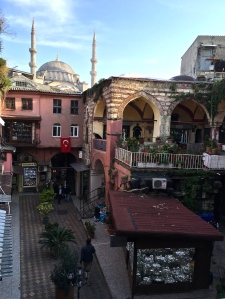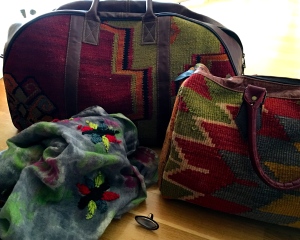March 23, 2016. If you’ve read my previous posts, you know what’s coming. Given my obsession with all things “oriental” (to use an old-school design term), I could barely wait to see what Istanbul’s Grand Bazaar had to offer. It’s billed as the world’s oldest shopping mall (it goes back to Byzantine times), and supposedly contains more than 4,000 vendors. We’d devoted only a half-day to perusing the place. What the heck were we thinking? In the end, I think we came back here three times.

To develop our plan of attack and learn the layout of all the loot, we combed our Rick Steves’ guidebook and bazaar map. Then we matched our “gift list” with a scheduled stop at the appropriate bedestens — clusters of shops selling similar merchandise. Knockoff designer handbags for my sister and niece? Head to the leather-sellers’ aisles. A Turkish coffee pot for our family in Seattle? Make a beeline for the metalworkers’ enclave. Silk scarves for my Chicago girlfriends? Check out the textile showrooms.

Of course, our best-laid plans to follow Rick’s walking tour fell by the wayside as soon as we entered the bazaar. Enticing smells, winding alleys, and enchanting colors, patterns, and textures all served to throw us off schedule and directionally off course. To be honest, this is not a difficult task; I have absolutely zero sense of direction. As Matthew jokes, “If you didn’t leave the bathroom door ajar, you’d never find your way out.” (It’s true.)

Add to that my ADHD around bright, shiny objects, and at one point, Matthew seriously considered putting a child harness on me. Poor guy. I think he feared I’d get forever lost in the labyrinthine passages of the bazaar. Or worse yet, he worried that left unsupervised, I might end up spending our entire vacation budget. (Not an entirely realistic anxiety, by the way. I may be a shopper, but I’m also a pro bargain hunter.) That being said, here’s a photo gallery of a just a few of the temptations likely to lead shoppers astray:

In truth, though, I was a bit concerned about my ability to negotiate a better price. It’s been a number of years since my days of hard-line haggling in Jerusalem’s souk, and I was worried my skills had grown rusty. But the one thing I was prepared for was the hawking. In every Near and Middle Eastern market, visitors must run the gauntlet of folks competing for business using high-pressure sales tactics.
The aggressive marketing pitches freaked Matthew out, and I think he was fairly miserable for the first hour. But in the end, he got the hang of things and began enjoying himself. I have to admit, he’s even better at getting a good deal than I am. Must be all the years of negotiating construction contracts. Part of the fun, though, was collecting the vendors’ opening lines, and then joining in with some witty banter of our own.
Here were some of our favorite approaches from vendors:
- Friendly: You’re from Chicago? I have a cousin from there. Special price for you.
- Romantic: I’ve seen you pass in front of my store three times now. It is fate; we are destined to do business together.
- Confident: Sir, I’m very, very good at my job. Let me help you spend your paycheck wisely.
- Direct: Lady, let me part you from your money.
- Devious: Lady, I remember your husband. He was here last week with another girl. A tall Russian blonde named Natasha. He bought her five purses. Maybe he’ll buy you more? I like you better, anyway, so I’ll give you a better deal.

I gladly fell in line with this last marketing ploy to put Matthew on the hot seat, but I scored only three purses (one for me, my sis, and niece). Apparently, Natasha is a bit more manipulative than I am. Anyway, this particular vendor specialized in designer knockoff leather bags. You’ll run into dealers of fake leather goods all over Istanbul, but those who are really serious about their craft go to a lot of trouble to make their forgeries almost undetectable.

The gentleman we shopped with explained the process. Each season, he purchases the latest models from Chanel, Céline, YSL, Hermès, etc., then has his staff replicate them. Part of his sales pitch included having us compare his products with those on the designers’ websites. To convince us that his handbags were made of real leather, he held a lit cigarette lighter to them under the premise that plastic melts but leather won’t. Not a true test, but entertaining and slightly unnerving, none the less.

Our next stop was the gold-seller’s section, but we didn’t have much luck here. I’d been told gold was super cheap in Istanbul. It’s not. So we moved on to Rick Steves’ recommended han (workshop) for the silversmiths. The square courtyard once served as an inn, but now shelters two levels of craftsmen specializing in household wares. We didn’t really expect to buy here, we just wanted to see master craftsmen at work.

Peering into the ground-floor shop windows, we oohed and awed at enormous silver goblets, platters, and pitchers, then made our way upstairs to the workshops. The ringing of metal brought us to an open door where an elderly man hammered away on what looked like an enormous baby bathtub. A younger man invited us inside for a closer look, explaining that his father Kapik, a 5th-generation Armenian artist, had been crafting handmade silver for more than 70 years.

We stuck our fingers in our ears as the hammering continued, wondering how Kapik hadn’t gone deaf yet. His son Alex explained, “He’s listening to the silver. It sings to him. The pitch tells him its thickness and when it has reached the proper shape.” Kapik stopped to show us his tools and template and explained the process (with Alex acting as translator.)

Turns out, his project was a footed silver bowl that would take three weeks to complete and resembled something Louis XIV would have loved. I wondered what it could possibly be used for in today’s modern world, and who would be able to purchase such an ornate and obviously expensive piece. Alex replied that it was for holding fruit and was a popular piece of tableware in Saudi Arabian households.

He then went on to show me eye-popping ritual pieces purchased by wealthy Jewish and Islamic New Yorkers, Californians, Indonesians, and Malaysians. But beyond religious items, his repertoire included historical reproductions and modern pieces sure to have broad appeal. So if you’re in the market for a silver épergne, candelabra, tea service, or anything else you can pass down to future generations, definitely check out Arto Usta — their stuff is amazing.

Being as our finances and household couldn’t accommodate such treasures, we moved on to the textile vendors. As you might imagine, I left drool marks on every window, but finally settled on purchasing some ikat silk from Gülipek. If you haven’t heard of it, ikat is kind of like tie-dyeing. But rather than hippy-dippy-trippy, it’s much more refined and has what my mom used to call a “flame stitched” look. I bought enough yardage to make myself a proper caftan; now I just need to bring back my sewing machine during my next trip home.

While on the topic of shopping, I should warn you that making any purchase whatsoever in the bazaar will require time, patience, and an empty bladder. You’ll exchange regular pleasantries with the vendor, catch up on family backgrounds, and consume copious amounts of Turkish tea before sealing a deal. Simply go along for the ride. And be prepared to spy the same item you just bought … at half the price in another store. Remember, you’re purchasing memories, not just stuff, and that’s what counts.

But if you’re intimidated by haggling, throngs of odiferous tourists, and a frenetic atmosphere akin to the Wall Street trading floor, there are always plenty of shops where purchases can be transacted in more peaceful surroundings. We found a real gem, right next to our hotel. The Heritage Nomadic Art Gallery had most everything you’d find at the bazaar, but without the accompanying stress and mayhem. (Great prices and high quality merchandise, too.) We blew the bulk of our gift budget here on weavings, pottery, jewelry, pillows, and of course, two carpetbags in which to haul our booty home.

Seeing our love of Islamic art, Uger, the wonderful owner of the store, volunteered to take us next door to Caferaga Medresesi, the Traditional Turkish Arts Center. It was once an Ottoman theological school that has now been converted into an artisan training studio. Uger introduced us to Josh, his brother-in-law, who assists in running the school and is an artist himself.

Our hotel’s walls feature many of Josh’s pieces — marbleized paper, a form of artwork known as Ebru, which he highlights with Hat, Arabic calligraphy. His eye-dazzling work had completely captivated me, so I was thrilled to meet the man who made them. First, he demonstrated traditional calligraphic techniques and showed us his wife’s work (she specializes in Tezhip — manuscript illumination). Then he took us on a tour of the school.

Designed by Mimar Sinan in 1449, the building consists of a series of domed cells organized around a central patio. We poked our heads into each room to watch students at work. Some practiced porcelain-painting techniques in the style of Iznik pottery, while others brushed up on their Nakiş skills — the art of creating tiny paintings and geometric patterns featuring flowers and birds. Everyone happily stopped to explain their process and show us samples of their accomplishments.

Many of the students spoke no Turkish and hailed from other countries (Germany, Ireland, and Israel, just to name a few). Josh explained that the school offered courses and even one-day workshops in many languages, with topics ranging from musical instruments to art and jewelry-making. And yep, you guessed it. Classes in marbleizing paper are now on my wish-list for future trips.
One last word about traditional Turkish arts. Most folks consider buying a rug when visiting Turkey. Heritage, the shop I mentioned above, has a fantastic selection. But one day while out walking, we were lured into Bilgin Hali by this incredibly kaleidoscopic carpet hanging outside the door. It reminded me of a cross between my grandmother’s shag rug and her chenille bedspread.

The proprietor explained that the rugs are from Karapinar, which is to the east of Konya, Turkey. They’re called tüylü, meaning “hairy,” and the ones we were drawn to were vintage (50-60 years old), in a style known as filik, the name for the long locks of mohair on the sides of kid goats. Because they’re not antique, nor particularly popular or durable, they’re inexpensive. So of course two made it into our suitcases.

Many folks will be aghast at this, because every tourist website warns of the dangers of purchasing Turkish rugs without much knowledge. I’m sure that’s sound council if you’re looking for a serious investment and are concerned with pedigree. But Matthew and I actually own quite a few kelims and other tribal carpets, and though none are antique or valuable (nor did we spend much money on them), we’ve never regretted a single purchase.
We buy what we love and want to live with, and that’s the best advice we can give anyone when shopping in Istanbul’s bazaar.






















